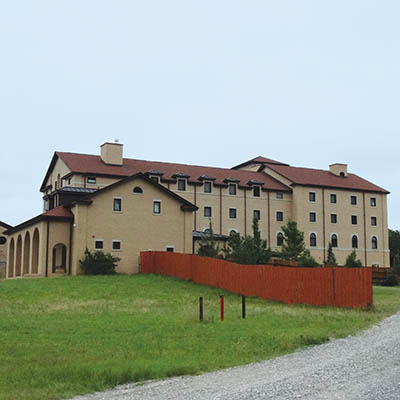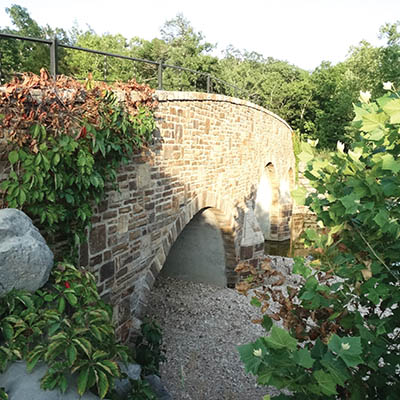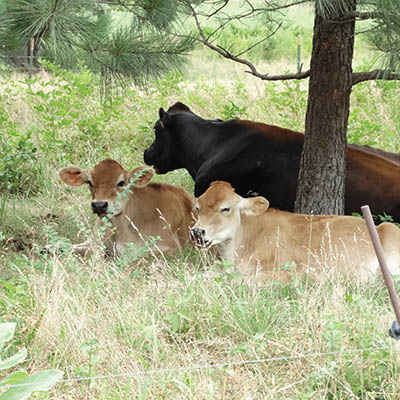Sister, sister
A nun and a “none” search for spiritual meaning in the hills of Hulbert
“What are we going to do at a monastery for five hours?” I asked my sister Theresa. She wanted to arrive hours before our appointment to speak with Father Bethel about monastic life at Our Lady of Clear Creek Abbey.
“Pray?”
I rolled my eyes.
Our family has been visiting this Benedictine monastery in the Ozark Mountains near Hulbert, Oklahoma for 13 years, though I haven’t been back in about ten. Our trips to Clear Creek were my parents’ version of a family vacation and my version of hell—no cell phone service and prayers all day. Our mom used to tell us that cloistered monks and nuns keep the world running with their prayers. I was never really sure what she meant.
I remember listening to the bells ring, calling the monks to prayer throughout the day, and listening to them chant in Latin. Attempting to quiet my mind and appreciate the serenity of Clear Creek was not something of which my teenage brain was capable. But I did enjoy the chanting. Returning to Clear Creek felt different this time, like a getaway with my sister rather than a mandatory family outing.
Theresa is the oldest of the five children in our family and I am the youngest. Our dad used to call us his Tweety Birds because of our blonde hair and big blue eyes.
When Theresa was in high school she was an atheist punk rocker. She still loves punk rock, but is now a Catholic nun at The Daughters of St. Paul, an order in Boston. Her interests include praying, reading, and scheduling her life down to the minute. I, on the other hand, am a social worker who loves listening to hip-hop and living in the moment.
“Did you ask the monks if we could stay the night at the guesthouse?” Theresa asked as we loaded our bags into my white hatchback.
“I figured we could play it by ear,” I responded, trying to sound casual. I averted my eyes and hoped she wouldn’t find out that we lacked concrete plans because I forgot to e-mail the monks. Theresa stopped what she was doing and scowled at me.
“I don’t play things by ear!” she said, aggressive for a nun.
Were I to meet my sister on the street, the chance we would become best friends is slim to none. But I adore Theresa for her unrelenting joy and wisdom—and because she puts up with me.
As we started out on the road, I did my best to dodge Theresa’s questions about our plans for the night. After I successfully derailed the conversation, we ended up having a deep conversation about the tendency we all have to make selfish choices.
“I’ve realized that most of us are selfish and we don’t want to love other people. And if we do something kind, most of us do it only because it is in our best interest, including me,” Theresa said.
“Yeah,” I agreed. “Sometimes it seems like a kind act is just another notch in someone’s personal growth belt. Or a ploy for affirmation or to get something in return.”
I started creating a mental laundry list of all my selfish flaws, wondering if my bright pink nails that I had done for a recent trip to Mexico were too silly and loud for a visit to a monastery.
We exited State Highway 82 and my tires kicked up dust as we began the second half of the drive on the gravel-covered West Monastery Road. An iron sign reading “Clear Creek Monastery” greeted us. We drove over a stone bridge that my sister told me the monks built by hand.
 I gasped—I’d not seen the new monastery since childhood, when the monks lived in a log cabin. The building was larger than I had imagined. Massive beige walls towered against the clear blue sky and I spotted two large wooden doors leading to the upper church. While still unfinished, the monastery is open for daily Mass and prayer.
I gasped—I’d not seen the new monastery since childhood, when the monks lived in a log cabin. The building was larger than I had imagined. Massive beige walls towered against the clear blue sky and I spotted two large wooden doors leading to the upper church. While still unfinished, the monastery is open for daily Mass and prayer.
In the 1970s, a group of students converted to Catholicism and became interested in monastic life while studying the classics of Western Literature at the University of Kansas. Some of the men traveled to the Notre-Dame de Fontgombault Abbey in France to enter the monastery in the hopes of beginning one in the United States.
In 1999, one of the original students, Father Francis Bethel, moved to Oklahoma with a group of other monks to begin the new monastery. The small group of monks lived in a log cabin and a barn. Now, just eighteen years later, there are over fifty monks living in a massive, newly built monastery nestled in rural Cherokee County.
Our first stop was the bookstore, which was filled with books and handmade items like rosaries, icons, pottery, and soaps. Recently, our brother-in-law raved about eating an entire wheel of monk-made cheese in one day on a visit to Clear Creek. We inquired about the cheese but they were out. Then, a monk came from behind the counter and I recognized Father Bethel.
I remembered Father Bethel well. He was the only monk who greeted and spoke to the people visiting the monastery; the rest were cloistered. My mom always grinned ear to ear in his presence, giggling at the quirky, mischievous things he said. He had a humble, self-effacing way of speaking with you. In conversation, he was focused, but would disappear suddenly with little explanation as if he had reached his daily limit of social interaction. He didn’t seem to have aged one bit in the ten years since we’d last met. He wore the same beige robe and worn loafers that looked handmade.
Father Bethel led us back to a room where we chatted about the monastic life, vocations, and the solace many find in the serene and prayerful atmosphere of Clear Creek.
 “It’s a place where you can reflect. It’s away from the world, all the noise, all the flashy lights, to really live before truth. To read, reflect, talk to men naturally in a healthy environment, away from all the billboards and things that are pretty distracting and alluring. We get a lot of people here that are not necessarily traditional Catholics,” Father Bethel said.
“It’s a place where you can reflect. It’s away from the world, all the noise, all the flashy lights, to really live before truth. To read, reflect, talk to men naturally in a healthy environment, away from all the billboards and things that are pretty distracting and alluring. We get a lot of people here that are not necessarily traditional Catholics,” Father Bethel said.
Theresa zoned in on what she told me she wanted to talk to him about—the Benedictine perspective on the virtue of humility. Theresa asked about the Rule of Saint Benedict, by which the monks live.
“What do you think is needed for a person to grow in humility?” she asked.
Father Bethel paused for a moment.
“Humility is truth and is based on knowledge, but it’s in the will, you have to want to be humble,” he said. “If you’re living in God’s presence you tend to forget about yourself.”
The monks at Clear Creek make their own clothing and shoes. They have a two-acre garden and an orchard with a vineyard (wine production is expected in the near future). Father Bethel estimated that the monks produce nearly half of their own food. They have cattle, sheep, chickens, and ducks, and manage all their own plumbing and electricity. Most of the costs of daily living are covered by all of the work the monks do during the day.
“We don’t have many [recreational] expenses such as bowling or watching television,” Father Bethel joked. But, he added that the monks rely on donations for the construction of the monastery.
We wandered to the lower level of the church to talk with an artist commissioned to make an oil painting for the monastery. A large man was kneeling on a pillow, his face inches from a canvas—roughly seven feet by seven feet. He made tiny, calculated brush strokes. Theresa and I were blown away by the painting’s brilliance. We later found out it was a reproduction of Flemish painter Jan Van Eyck’s “Ghent Altarpiece.” This version was very similar, but more vibrant with emerald green grass and shades of chestnut red.
He popped up to greet us.
“Hello!” he almost shouted. “I’m Gregory Wietrzychowski, the resident artist.” Theresa and I barely introduced ourselves before Gregory began to share his painting technique. He told us that he knew of only three people in the world who paint like he does. He dipped his miniscule paintbrush in a little metal pot of turpentine before applying it to soften the oil pastel.
A combination of inspiration and coincidence led him to Clear Creek earlier this year. The Milwaukee native discovered his love for painting when he was a bodybuilder working as a bouncer in a pub in England. After an apprenticeship with an artist, Gregory moved to Paris, where he painted on the streets for 10 years. There, he converted to Catholicism and began devoting his artistic talent to religious work. Last November, he wrapped up a two-year pilgrimage in which he visited 150 Catholic shrines across the United States, mostly on foot. Part of the rules of his journey included not asking for money or rides, only accepting them when offered. He told us about the beautiful acts of kindness from strangers at moments when he needed them most on his journey.
“I had a feeling you two would still be here,” said Father Brown, who had been inquiring about accomodations for us. He told us the caretaker of the guesthouse might not be able to take us in because she was ill. We would have to check back with him after Vespers, the evening prayer. We thank him for trying and walked upstairs to attend Vespers.
Theresa and I sat down in a pew as the monks filed in. They began to chant in Latin and wave of emotion rippled through me. I teared up.
My life in Tulsa is fast-paced, so much so that I rarely afford myself the time to sit and reflect in silence. The monks, I realized, do so multiple times a day, sometimes for hours at a time. I wondered what I’ve missed out on by being too busy to slow down, to notice.
After Vespers, Father Brown told us that we could stay the night, but we needed to take extra precaution because of the caretaker’s health. We drove up a tree-lined gravel driveway toward a two-story house flanked by a large, fenced in vegetable garden. The caretaker, Kim, came out to meet us. She was wearing a long black skirt and a veil to cover her hair. She clasped her hands together and told us how happy she was to have us. She led us into the dining room where two places were set on a candlelit table and a CD of the monks chanting played in the background.
“I was feeling sick all day but I am feeling so much better now that you have arrived,” she said, sniffling.
Theresa and I look at each other, dumbfounded by her genuine kindness and grateful for her hospitality. Kim returned with two bowls of homemade vegetable soup, warm bread with butter, a bowl of grapes, a plate of crackers with monk-made asiago cheese, and a salad of vegetables from her garden.
“Is she an angel?” I whispered to my sister.
Theresa exploded into quiet laughter.
 After dessert—homemade ice cream made with Clear Creek cows’ milk—Theresa and I went on a walk and marveled at the love and generosity we were shown by the monks and Kim.
After dessert—homemade ice cream made with Clear Creek cows’ milk—Theresa and I went on a walk and marveled at the love and generosity we were shown by the monks and Kim.
That evening, we attended night prayers, held in Latin. With Kim’s patient guidance, we stumbled our way through.
The following day, we woke up early to attend Low Mass and Morning Prayer at the abbey. Afterwards, I was excited.
“Ok, I am inspired and invigorated,” I told Theresa. “I’m going to put my phone away and be more present!”
“We’ll see how that goes,” she teased back.
When we turned out on the dusty gravel road heading back to Tulsa, the monastery hung in the rearview mirror. I imagined the monks silently going about their day, praying for peace.
Even if I don’t totally understand that, I’m glad I live in a world where it happens.


.jpg)
.jpg)
